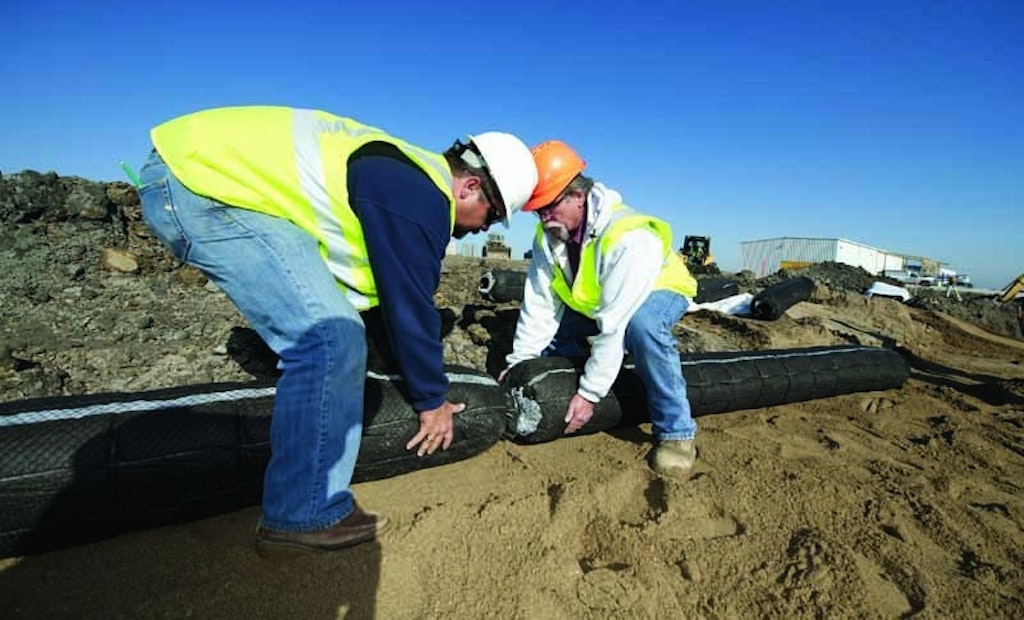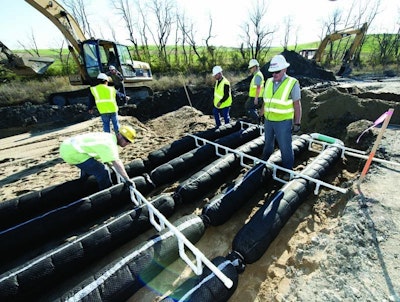
Interested in Alarms/Controls?
Get Alarms/Controls articles, news and videos right in your inbox! Sign up now.
Alarms/Controls + Get AlertsOfficials at Triad Mining wanted to open a new underground coal operation at its Log Creek Mine in Spurgeon, Indiana. In preparation, they built a structure housing lavatories and showers for 90 miners working two 12-hour shifts, an administrative office and a machine shop.
Tom Sutton, Triad general manager, hired Mark Hacker, owner of Hacker Plumbing and Drilling in Vincennes, Indiana, to design the onsite system. “The greatest challenge was being surrounded by hundreds of acres of mine spoil up to 80 feet deep,” says Hacker. “There wasn’t one area with undisturbed soils for the drainfield.”
He turned to David Ralston, president of Soil Tech Inc. and a soil scientist with mine spoil experience. “Dave found a usable site and was our intermediary with the state Department of Health,” says Hacker.
The department had assigned a loading rate of 0.25 gpd per square foot for disturbed soils, but significant voids between boulders threatened to short-circuit effluent. Hacker, concerned about achieving uniform treatment levels, called Dennis Hallahan, environmental engineer at Infiltrator Water Technologies, for design assistance.
Their solution treats effluent via a pressurized modified hybrid sand filter that reduces the drainfield’s footprint by almost half. “Instead of needing 4,200 feet of pipe-and-stone trenches, we met the application rate with 2,000 feet of Infiltrator advanced treatment leachfield conduits,” says Hacker. According to Hallahan, Log Creek is the largest ATL installation in the country to date.
Site conditions
Soils are well-drained mine spoil (large and small boulders mixed with soil), shale and limestone.
System components
Hacker and Dale Kruse, P.E., of Kruse Consulting, designed the system to handle 3,150 gpd. Major components are:
- 3,500-gallon concrete sediment tank (precast single-compartment tanks from Rex Vault Services, Odon)
- Two 3,500-gallon septic tanks with PL-525 effluent filter (Polylok) at second tank outlet
- 3,500-gallon dose tank with duplex SP33 1/3 hp Barnes pumps (Crane Pumps & Systems)
- Two two-hole distribution boxes (Rex Vault Services)
- 200 ATL conduits (Infiltrator Water Technologies)
- Duplex control panel (Septic Products Inc.)
System operation
Showers in the primary locker room drain to the sediment tank through a 4-inch PVC pipe. Graywater, comprising 75 percent of the hydraulic flow, then enters the first septic tank, as does wastewater from a second 4-inch pipe leaving the building.
The system relies on gravity until effluent reaches the dose tank with two 2-inch force mains, one each for zones one and two and zones three and four. Twice daily, on-demand alternating pumps discharge 750 gallons at 30 gpm, 100 feet to the designated zones. The 102- by 22-foot zones with five 100-foot-long laterals on 24-inch centers create a 408- by 88-foot drainfield.
A 4-inch distribution pipe inside the 10-foot-long by 12-inch-diameter conduits has 1/2-inch orifices spaced 6 inches apart at 2, 6 and 10 o’clock positions. Dosed effluent percolates down through large-diameter engineered aggregate encased in coarse geotextile, then small-diameter engineered media in fine geotextile. After leaving the conduits, liquid infiltrates through 24 inches of system sand (ASTM C33) to mining spoil.
“The system is designed to infiltrate the dose volume before the next one arrives,” says Hallahan. “However, the conduits have adequate storage capacity to handle abnormally high flows, then infiltrate them over time.” During NSF/ANSI Standard 40 testing, the system achieved average treatment levels of 9 mg/L CBOD5 and 11 mg/L TSS.
Installation
Hacker and his four employees ran sewer lines 200 feet to the septic site, then Brandon Spanger, co-owner of B & M Excavating in Westphalia, Indiana, over-excavated the four 11-foot-deep tank holes by 50 percent using a Volvo EC300DL long-reach machine. “Mine spoil wants to cave in or slough off, making excavations challenging,” says Hacker. “Brandon has the expertise to keep my men safe.”
Safety was a major issue for those working around the long-reach excavators. The crew wore bright-colored safety vests, to increase visibility, and hard hats. “I stressed vigilance and caution every morning,” says Hacker. “The installation was simple, and I didn’t want that lulling the men into complacency.”
It took two days to excavate the holes and set the tanks on 24 inches of compacted crushed limestone. “Mine spoil is fluid and cobbly, requiring deeper beds to stabilize the tanks,” says Hacker. Rex Vault Services delivered the tank halves and set them, then Triad employee Randy Moore backfilled using the mine’s Caterpillar 320C long-reach excavator.
Digging the conduits’ 24-inch-deep trenches held no safety concerns. They were filled with washed sand and the conduits laid on top. The system depends on 12 inches of sand between conduit rows, 12 inches adjacent to the first and last row in each zone, and 12 inches extending beyond both ends of the rows.
To ensure the proper distance between conduits, Hacker designed and fabricated five spacers from reinforced 1-inch PVC pipe. “I wanted something that was white, lightweight, rugged and reusable,” he says. “The spacers also prevented the conduits from shifting during backfilling.”
Hacker used a Spectra Precision Laserplane 500 to ensure the sand beds were level before his crew laid the first five conduits in series. They used Hacker’s spacers to maintain 24-inch centers, then connected the second series of conduits end to end with 4-inch internal pipe couplings. As soon as they moved to the next series of tubes, Moore backfilled the previous rows with sand. Once Moore stabilized the previous rows with sand, workers moved the spacers to the next series, enabling Moore to finish backfilling. Each zone took two days to install, then it was covered with 12 inches of topsoil hauled from another area of the mine and seeded.
Maintenance
Hacker holds the annual renewable maintenance contract. Twice a year, he checks the pumps, capacities, floats, alarms and drainfield.








